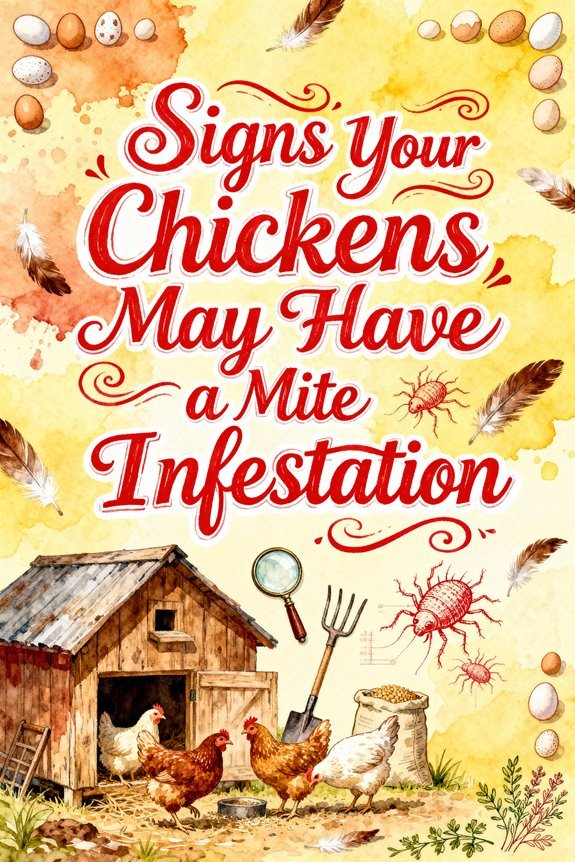Signs Your Chickens May Have a Mite Infestation
Watch for key behavioral changes in your chickens, including excessive scratching, nighttime restlessness, and increased dust bathing activity. You’ll notice deteriorating feather condition, particularly around the vent and under wings, along with visible skin irritation and pale wattles indicating potential anemia. Inspect your coop at night for tiny dark insects or red smears in cracks and crevices. Understanding specific mite species and their patterns will guide your treatment approach.
Behavioral Changes in Your Flock
When chickens become infested with mites, they’ll exhibit distinctive behavioral changes that serve as early warning signs for owners. You’ll notice excessive scratching behaviors, particularly at night when mites are most active. Your birds may display heightened agitation, frequently rubbing against coop structures and engaging in obsessive preening or dust bathing. Sleep deprived birds can experience dangerous cannibalistic tendencies. Some hens may avoid their nesting boxes completely, leading to irregular egg laying patterns.
Watch for disruptions in normal social dynamics as irritated birds become more aggressive or withdraw from the flock. You’ll observe decreased foraging activity and altered sleep patterns, with chickens showing visible restlessness during nighttime hours. Northern fowl mites can complete their lifecycle within seven days, leading to rapid population growth. Your flock’s typical pecking order may deteriorate as birds experience increasing discomfort. Pay attention to changes in movement patterns, including reluctance to roost in certain areas or unusual limping, which can indicate concentrated mite activity in specific body regions.
Visible Signs of Feather Damage
A thorough examination of feather damage reveals distinctive patterns indicative of chicken mite infestation. You’ll observe tattered, ragged feathers, particularly around the vent and under the wings, where mites concentrate their feeding activity. Regular inspection around these areas for visible nits at base helps identify early stages of infestation. The feather condition deteriorates as mites remove blood and cause irritation, leading to characteristic matting and dark gray discoloration. Northern fowl mites can multiply quickly and spread through direct contact between your chickens. Chickens experiencing severe blood loss may develop pale combs and show signs of anemia.
Critical diagnostic indicators include patchy feather loss, white clusters of nits at feather bases, and accumulation of mite debris near affected areas. You’ll notice the most severe damage in the vent region, where mites typically lay their eggs. The compromised feathers become brittle, losing their natural gloss and structural integrity. This deterioration often accompanies visible skin irritation, manifesting as redness or scabbing beneath damaged feathers, signaling active mite feeding.
Nighttime Activity and Sleep Disruption
During nocturnal hours, chickens infested with mites exhibit distinctive behavioral patterns that disrupt their natural sleep cycles. You’ll notice increased grooming activity, particularly between 5 to 11 hours after darkness, when mites emerge to feed on your birds. This nighttime discomfort manifests through observable stress indicators, including persistent restlessness and reluctance to roost in their usual spots.
Your chickens may demonstrate atypical nocturnal behaviors as they attempt to alleviate the irritation caused by these parasitic arachnids. The resulting sleep deprivation can markedly impact their health, leading to systemic stress responses. The mites specifically target the unprotected skin areas when feeding on chickens at night. Carefully inspect the hock joint regions and coop crevices during evening checks to identify potential infestations. If you observe your flock avoiding their roosting areas or displaying excessive preening during nighttime inspections, these behaviors strongly suggest an active mite infestation requiring immediate intervention.
Egg Production Warning Signs
Beyond the nocturnal disturbances, mite infestations manifest through significant changes in egg production patterns. You’ll notice a quantifiable egg production decline of up to 15% with northern fowl mites and 20% or more with poultry red mites. The mite impact extends beyond quantity to affect egg quality through multiple physiological mechanisms.
Watch for deteriorating feed conversion efficiency in your flock, as mites compromise your birds’ ability to utilize nutrients effectively. Clinical indicators include weight loss and anemia, particularly in severe infestations. You’ll observe these symptoms correlating directly with reduced laying performance. These issues become especially concerning when infestations reach 10 to 15 mites per bird, signaling the need for treatment intervention. The stress response from continuous mite feeding triggers hormonal changes that further suppress egg production capabilities. These manifestations, when occurring simultaneously, strongly indicate an active mite infestation requiring immediate intervention.
Inspecting Your Coop for Mite Evidence
Successful mite detection requires systematic nocturnal inspection of your coop’s key structural components, particularly the roosts and perches where these ectoparasites concentrate their activity. During coop inspections, you’ll need to examine wooden structures with a flashlight, looking for tiny dark insects and characteristic red smears when surfaces are wiped with white cloth. Pay special attention to cracks and crevices where mites shelter during daylight hours. Red mites will appear bright crimson after feeding on chicken blood, making them easier to spot during nighttime checks. Consider applying natural desiccant dusts to problem areas during your inspection to help control any detected parasites. Regular use of permethrin sprays can help prevent severe infestations from developing.
For effective mite identification, inspect the coop 5-11 hours after darkness when parasites are most active. Focus on areas near roosting bars, checking for egg masses and debris at feather follicles. You’ll find evidence concentrated around the vent area and leg-height roosts. Consider applying painter’s tape sticky-side out on roosts to quantify infestation levels through trapped specimen counts.
Physical Health Indicators to Watch
A thorough clinical assessment of chicken mite infestations requires monitoring specific physical manifestations across multiple body systems. You’ll need to examine your birds for distinctive physical appearance changes, including damaged feathers, particularly under wings and around the vent area. Critical skin health issues manifest as redness, scabbing, and dermatitis in affected regions. Regular dust bathing areas help chickens naturally control external parasites. Using a flashlight inspection can reveal mites hiding in crevices and feathers.
Monitor your chickens’ combs and wattles for paleness, which indicates potential anemia from blood-feeding mites. Check legs and feet for raised, thickened scales and crusty formations – hallmark signs of scaly leg mite infestation. Watch for behavioral indicators like excessive scratching or restlessness, especially at night. The nocturnal blood feeders are most active during darkness hours, making nighttime inspections crucial for detection. Secondary complications may include weight loss, reduced egg production, and increased susceptibility to other infections due to compromised health status.
Common Symptoms of Anemia
When monitoring chickens for mite infestations, recognizing anemia symptoms becomes particularly important as these parasites can trigger severe blood loss. You’ll notice affected birds displaying pale wattles, combs, and legs due to reduced red blood cell counts. Common anemia causes include blood loss from ectoparasites, nutritional deficiencies, and viral infections like CAV. The virus typically shows detectable virus-neutralizing antibodies around 21 days after infection. Regular inspection of your chickens’ scaly leg areas can help catch mite problems before they cause anemia. While mites can cause fluid buildup similar to water belly condition, the treatment approaches differ significantly.
Watch for birds exhibiting lethargy, reduced appetite, and weight loss. Internal or external hemorrhages may also be present. For proper anemia treatment, you’ll need to address both the underlying mite infestation and support your birds’ recovery through nutritional supplementation. Blood tests showing PCV levels below 27% confirm clinical anemia. Since anemic birds experience immunosuppression, they’re more susceptible to secondary infections, making swift intervention essential.
Understanding Different Types of Mites
To effectively diagnose mite infestations in poultry, you’ll need to distinguish between several key species that commonly affect chickens. The mite classification includes Chicken Mites (Dermanyssus gallinae), which feed nocturnally and appear white to red depending on feeding status, and Northern Fowl Mites (Ornithonyssus sylviarum), which remain active throughout the day and night. These parasites can thrive in humid conditions and breed most actively during spring months.
You’ll find Scaly Leg Mites (Knemidokoptes mutans) specifically targeting legs and feet, creating distinctive crusty lesions, while Tropical Fowl Mites (Ornithonyssus bursa) behave similarly to their northern counterparts. Each species’ mite life cycle spans approximately one week, though their behaviors differ markedly. Chicken Mites hide in crevices during daylight, while Northern and Tropical Fowl Mites remain on the bird continuously, primarily around vent areas.
Prevention and Treatment Options
Managing mite infestations requires implementing extensive prevention strategies and targeted treatment protocols. You’ll need to maintain rigorous environmental controls through regular coop sanitization, removing droppings and old bedding that serve as potential mite habitats. Establish dedicated dust baths containing diatomaceous earth or wood ash, enabling your flock’s natural parasite defense behaviors. Checking for blood smears on legs can help identify mite problems early. Silkie chickens require extra attention due to their dense, fluffy plumage that can harbor mites. Reduced egg production often signals an advanced mite infestation that needs immediate attention.
For active infestations, apply approved mite sprays containing Spinosad directly to birds and coop surfaces after temporarily removing food and water. Monitor effectiveness using mite traps, classifying population levels to determine treatment intensity. Support your flock’s immune system through balanced nutrition and stress reduction. Consider incorporating garlic supplements to enhance natural mite resistance. Seal cracks in coop surfaces and maintain proper ventilation to minimize environmental conditions conducive to mite proliferation.




